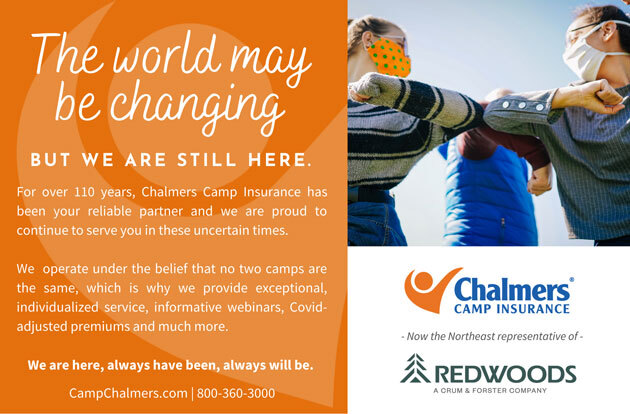That’s always good advice, but this past summer we had to be reminded of it repeatedly. For us it meant spending a little time thinking about Buridan’s donkey.
Jean Buridan was a 14th-century French philosopher who proposed that a donkey placed halfway between a bale of hay and a bucket of water, not knowing which to choose, will die of both hunger and thirst. It’s a false choice. He could have gone to the water first and then to the hay. Our donkey choice this summer meant standing between camper safety and camper growth through a very scary time. We had to learn to navigate the path between the water and the hay. It was a scary trail with lots of roots to trip on, but each week we learned to walk it a little better. Of course, we did not know that last May. In May we were asking whether there was any trail at all
Now, in the fall, we can affirm that yes, there is a trail. It can be carefully walked, and the first step is to be thoughtful about who you will bring with you. This means choosing your campers and leadership team very carefully. Specifically, choosing people who are as serious as you are about keeping COVID-19 out of your camp. We required a mixture of self-selection, precamp testing, quarantining, and documented health checks and exposure history before arrival, as well as some careful check-in procedures. None of these alone would have been enough, but each diluted the risk. To shift metaphors, there is no silver bullet, but the more lead we put in the air the more likely nothing’s getting through. (In retrospect we might have reloaded one more time and also administered a final rapid test upon arrival.) So, Plan A was to not let COVID-19 in to begin with. Plan B was to be ready if Plan A failed. And this was the awkward part.
Our checklist evolved during each session as we watched, tweaked, and updated our procedures. You think you have it covered until someone posts the first time-off schedule and your socially distant counselors rush together to read the list — but the key was to keep instructing and to take it very seriously. Put another way, a dream is different than a plan — and a COVID-19 plan is useless unless it is consistently revised and executed.
Our 2020 camp season was truly a Buridan’s donkey scenario — and the reason why some (most) of the strongest, mission-driven programs I know chose not to open this summer. Let me say that again. Some of the best, most thoughtful, and effective leaders I have seen in my 30 years as a camp professional chose to not open their programs. We wrestled with the same decision. How could we run a safe camp and run a great camp? How could we get both the hay and the water?
Three things we learned:
Camp Is Adaptable
For 75 years we ran a specific, camp-wide, skills-based program. Our campers chose activities to specialize in and returned summer after summer, improving in those skills. We also had large-scale, full-camp activities where the singing was loud and the cheering overwhelming. These were at the root of our tradition and required lots of campers being very close and crossing age groups. COVID-19, on the other hand, required smaller, cabin-centric groupings. While we did often add layered protocols and gathered in larger groups, even these required careful cohorting. The point is, we had to change some fundamental practices.
Interestingly, we found that some of our program updates were actually better than what we had been doing before. Campers were more socially connected to their cabin-mates than we had ever seen, and the result was an overwhelming number of campers and staff who reported that 2020 was their best-ever summer at camp. We learned that both our business model and our program model are more adaptable than we had expected.
Parents Really Are the Problem
This was the first year that parents were not allowed in cabins to help their campers move in — and the result was brilliant. Campers made a quick transition from the car to the camp, and we saw homesickness decrease and social connections among campers increase dramatically. It’s in our parental DNA to resolve challenges for our children — we cannot help ourselves — but when our children see our concern, they use it as building blocks for their own anxiety. Every camp I have spoken with that operated this summer plans to continue their drive-through drop off. Every single one.
Parents Really Are the Solution
After watching their children quarantine for months, our parents felt the importance of camp this summer more than ever before, and that colored their campers’ experiences, too. Our camp parents were partners. They worked hard to get their campers here and wanted it to work as much as we did. The result was that their campers were ready to jump into whatever we offered; they were ready to take chances, and they were ready to grow.
Four pro tips for running camp during a pandemic:
One: The Distance between Us
There’s a reason so many people are putting stickers on the floor to indicate where people should stand. Apparently, without that guidance, people have an especially hard time envisioning a distance of six feet. In the camp world, without stickers, six feet equals about 18 inches, and ten feet equals about six feet. So, tell everyone to stay ten feet apart.
Two: The Ins and Outs
Pay special attention to coming in and out of spaces. Entering and dismissing by cabins worked for us.
Three: Transparency
The only way we would run camp was if everyone knew exactly what they were getting into. We did two things before campers came and two things after they arrived.
Before Arrival
- We published a preliminary operating manual that included as much information as possible about what camp would look like (and thanks to Camp Champions and Camp Pinnacle for letting us use large portions of theirs). We knew we hit the mark when we received calls from some families letting us know their campers weren’t coming because they weren’t sure the program we were describing would be a good fit for them.
- We opened the refund door as wide as possible. Families and staff needed absolute freedom to make their best decisions. While this was frightening and my hand cramped writing refund checks, almost everyone let us keep at least their deposits for next summer, and, at this point, it looks like our return rate will be very strong.
During Camp
- We got vulnerable. We communicated often, starting with weekly reports from our health center. We told parents everything. We told them about cases of lice, how many campers were seen every day — how many bug bites, constipated campers, and bumps and bruises we were seeing. If something was scary, we told them that too. Anytime a camper presented with a fever or other concerning symptoms, we immediately notified parents whose children were in the cabin involved — and we let them know every time that concern was resolved. Again, the idea was for them to know exactly what they were getting into so they could make the best decisions for their families.
- We shared appropriate photos. Our goal was to let parents see exactly what was happening, but we also needed to avoid the wrong impression. Campers did not have to wear masks with others from their cabins — these were our basic family units — but it was impossible for outsiders to know who was in a cabin together. So we chose to show no unmasked pictures unless everyone was at least six feet away from one another.
Four: The Right Personal Choice
Life is too short to spend every night lying next to your spouse and asking if they’re awake, and if so, if they’re thinking about the same thing you are — specifically, that #$*#% CIT who wasn’t wearing a mask at lunch. You have to know your camp and your staff well enough to make the right decision when it presents itself, and then make the next decision when that comes along. There’s just not enough margin for second guessing. Your families must do the same.
A lot of people think Buridan plagiarized his donkey (at least the idea) from Aristotle. If so, he might have missed Aristotle’s most important point. The donkey is most likely to choose the thing he is standing closest to (hay or water) and die of thirst or hunger alone. Camp directors, if you’re standing next to the hay, then you need to listen to other donkeys nearer the water, and vice versa. We can teach and learn about the critical steps on the path from each other. I’m going to be calling some of you who did not operate this summer, and I’ll hope my phone rings soon as well.
Photo courtesy of Camp Merri-Mac, Black Mountain, North Carolina
Adam Boyd, DMin, and his wife, Ann, are the executive directors of camps Merri-Mac for Girls and Timberlake for Boys in Black Mountain, North Carolina. Adam is the author of Jonathan Edwards, Beauty and Younger Evangelicals and also serves on the board of the North Carolina Youth Camp Association.


